Doctor(ing) Disaster
“Praxeus” finds Doctor Who wading into the climate crisis without abandon or regret.
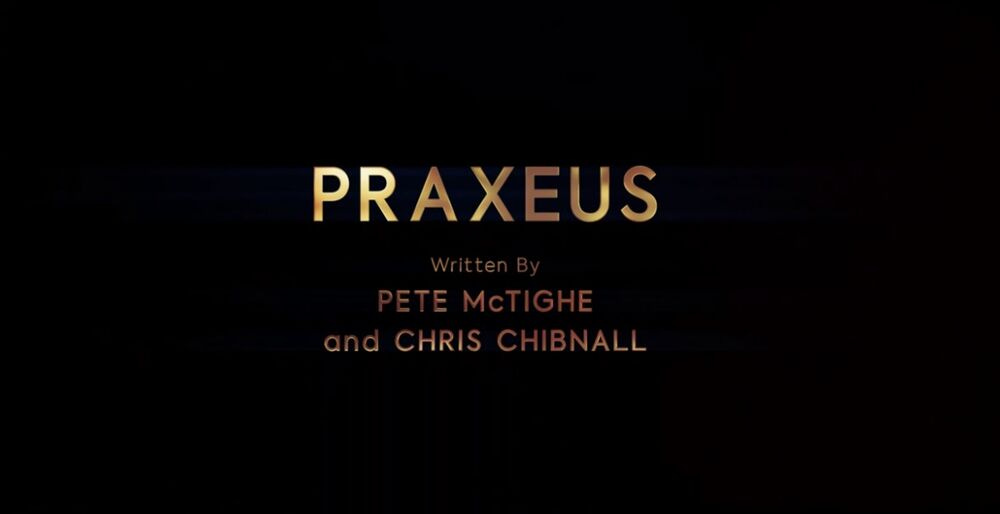
Doctor Who
“Praxeus”
Series 12, Episode 6
Written by Pete McTighe and Chris Chibnall
Directed by Jamie Magnus Stone
Starring Jodie Whittaker, Tosin Cole, Mandip Gill, and Bradley Walsh
Guest Starring Joana Borja, Warren Brown, Soo Drouet, Molly Harris, Thapelo Maropefela, Matthew McNulty, and Gabriela Toloi
49 minutes
Original broadcast 2 February 2020
1. Eco Blues
In a move guaranteed to incense some quarters of Doctor Who’s capacious and capricious audience, “Praxeus” returns the program to the explicit environmental concerns that characterize its thematic cousin (of three episodes earlier), “Orphan 55.” The rage provoked by that installment’s storyline (about far-future Earth becoming a polluted hellscape so terrible that it mutates human beings into snarling beasts) remains palpable enough that “Orphan 55” still holds the dubious distinction of receiving the lowest-ever Internet Movie Database (IMDb) user rating (4.2 out of 10) of any New Who episode since the program’s 2005 inception.
Some Whovians clearly despise watching stories about the climate crisis, ongoing environmental collapse, onrushing ecological cataclysm, or whatever term you prefer to describe the subject of “Orphan 55,” “Praxeus,” and their cautionary tales about humanity’s shabby treatment of its home planet.
“Too preachy!,” these fans cry.
“Stop lecturing us!,” they wail.
“We come to Doctor Who for time-travel whimsy, not political grandstanding dressed up as drama,” they pout.
Such bullheadedness deprives these viewers of some powerful messages offered by “Praxeus” and its kindred: the aforementioned “Orphan 55,” Series 11’s “Arachnids in the UK,” and Series 8’s “In the Forest of the Night,” to name only three examples. This churlishness also misperceives Doctor Who’s relationship to the political, social, cultural, economic, and, yes, ecological currents in which the program, its creators, and its viewers all swim. Even hasty examinations of Classic Who (1963-1989) and New Who (2005-Present) reveal the franchise’s longstanding commitment to a gentle liberal humanism that is unafraid to get salty when necessary, that sometimes cloaks its real-world observations in silky dramatic gloves, but that (happily) removes those mittens for more bare-knuckled political commentary when the moment calls for it.
And since our present moment calls for more than a few environmental donnybrooks, I commend “Praxeus” for doing just that without abandon or regret. Viewers who criticize this outing’s (as well as the wider franchise’s) engagement with real-world issues either haven’t watched as much of the old show (or the new show) as they claim or, perhaps, they metaphorically wall off the bits they loathe, rather like Montresor bricking off Fortunato in Edgar Allan Poe’s memorable 1846 short story “The Cask of Amontillado.”
“Praxeus” begins with one of the Chibnall era’s signature salutes to the disaster movies that the showrunner so clearly and dearly loves: disparate characters confront terrible dangers in different, seemingly disconnected locales that, we sense, will inevitably reveal hidden connections. “Resolution,” the 2019 New Year’s Day Special, begins this way, as does Series 12’s premiere episode, “Spyfall: Part One,” while “Fugitive of the Judoon” tampers with this trope by jumping around the morning routine of its chief guest character, Ruth Clayton (Jo Martin), aka the Fugitive Doctor, to evoke an impending sense of ruin that the episode soon fulfills.
Although my description may make “Praxeus” sound like little more than a doom-and-gloom voyage into environmental tragedy, it instead develops into a more hopeful ecological parable than its reputation suggests.
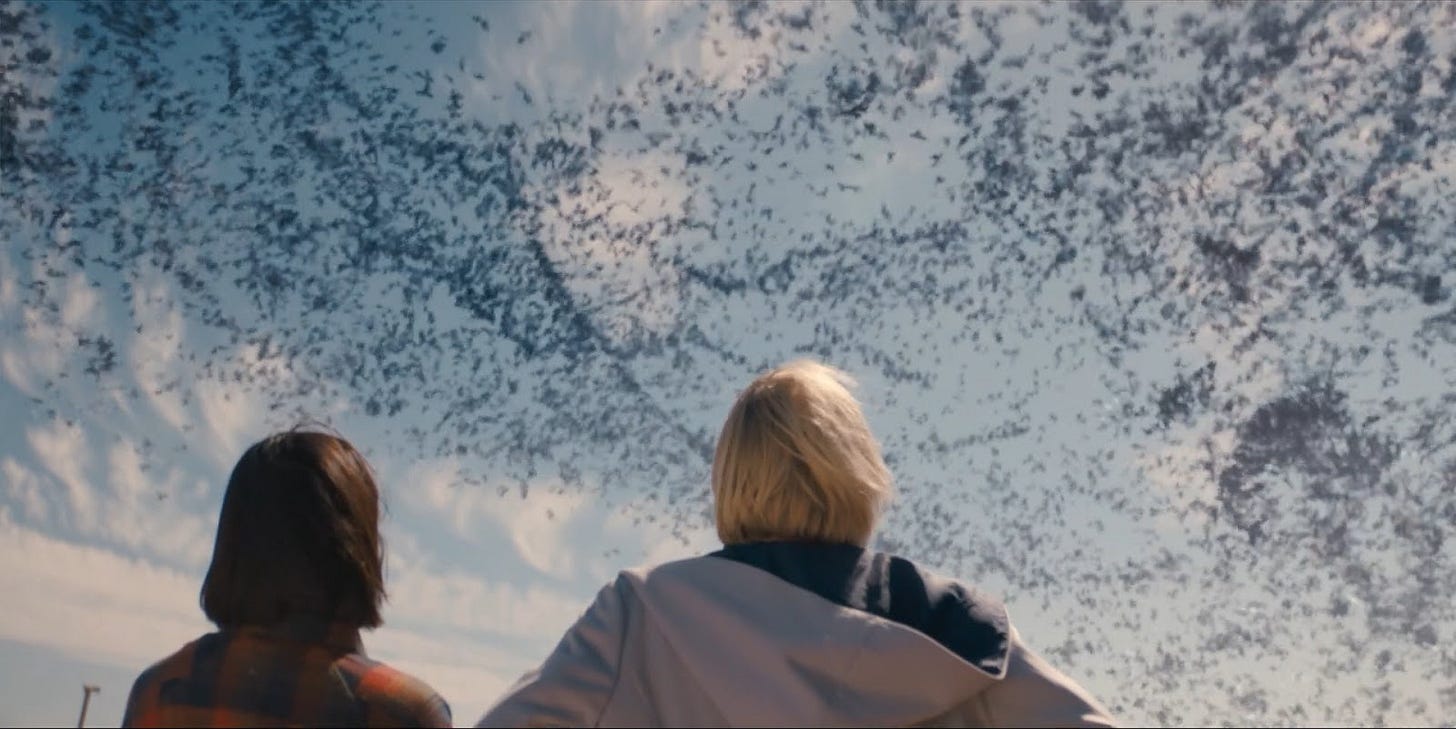
2. Red Alerts
“Praxeus” mercifully launches its story with no exposition, taking us from the crashing Soyuz space capsule of English astronaut Adam Lang (Matthew McNulty)—a man who tries but fails to prevent disaster as his craft re-enters Earth’s atmosphere while returning from the International Space Station—to off-duty police officer Jake Willis (Warren Brown) tackling a shoplifter to the floor of an English supermarket, an action that gets Jake gently dismissed by a supervisor named Joyce (Soo Drouet). We then meet travel vloggers Gabriela Camara (Joana Borja) and Jamila Velez (Gabriela Toloi) discovering mounds of plastic trash on the banks of an unnamed Peruvian river, a place that, Gabriela says, was once the world’s most beautiful example of its kind.
When Jamila disappears from their tent that night, the upset Gabriela encounters Ryan the next morning as he collects dead birds from the rubbish all round them (while ominous avian flocks spin in the sky overhead). Yaz and Graham, meanwhile, track strange energy signals in Hong Kong when they encounter Jake, who, while drinking in a pub during an earlier scene, receives a text message from Adam pleading with Jake to find him. Adam, the pride of the European Space Agency, happens to be Jake’s husband, so, despite Jake’s aversion to international travel, he flies to Hong Kong hoping to find his lost husband, who, as far as anyone else knows, perished in the capsule’s crash.
And where is the Doctor? Oh, running along a beach in Madagascar tracking one surviving sailor from an American submarine that’s gone missing in the Indian Ocean. She screams for help from two local laboratory workers, Aramu (Thapelo Maropfela) and Suki Cheng (Molly Harris), whose well-stocked facility sits near the waterline, a convenient placement that doesn’t raise alarm bells—even if it should—given the furious pace and life-threatening events confronting the Doctor.
So, yes, disaster-movie vibes all the way.
“Praxeus” quickly unites these characters to solve the many quandaries they face, only to see this plucky group, in the best Doctor Who tradition, realize that one central mystery connects them all. After the exhilarating revelations of “Fugitive of the Judoon,” audiences might expect Chibnall to plumb these possibilities in this follow-up installment, but pursing that path is neither the showrunner’s nor New Who’s manner. From Series 1 onward, shocking—and even game-changing—events frequently give way, in the next outing, to smaller domestic concerns.
“Praxeus,” in a salutary turn of events, simultaneously fulfills and bucks this trend by enmeshing Team TARDIS and its guest characters in a plot that may seem smaller in scale than “Fugitive of the Judoon” calling into question all that we know (or think that we know) about the Doctor’s past, but, by the time “Praxeus” concludes, this entry sees the Doctor and her friends racing to find the cure to a bacterial infection (named, unsurprisingly, Praxeus) that threatens all life on Earth.
“Praxeus,” in other words, cannot be confused with a quiet domestic drama despite focusing, in key scenes, on the relationships among its characters (principal and guest), foremost among them Jake and Adam’s troubled marriage. “Orphan 55,” as my review notes, gets this aspect of its storytelling wrong by tackling, without much subtlety, the hackneyed mother-daughter tensions between Laura Fraser’s Kane and Gia Ré’s Bella.
So, seeing writer Pete McTighe (alongside Chibnall) sketch Adam and Jake’s problems with greater sophistication is a relief. McTighe and Chibnall’s work is aided enormously by the good acting of Warren Brown, Matthew McNulty, and, in a finely wrought scene that finds Graham counseling Jake about the regrets that will haunt him if he (Jake) doesn’t share his doubts and vulnerabilities with his spouse, the ever-great Bradley Walsh.
All questions about the relationship between Gabriela and Jamila, however, go unexplored when Ryan and Gabriela find the recently deceased Jamila in an abandoned Peruvian hospital. Large, tannish, shard-like encrustations cover her face and neck, but soon overtake Jamila’s entire corpse, causing it to disintegrate into dust.
This sight, accompanied by a crunching sound that culminates in Jamila’s body exploding into fine particles, is not merely fast but also sickening, so that when the same process overtakes the body of the dying American submariner that the Doctor discovers on that Malagasy beach (accompanied by flocks of birds assembling, tumbling, and turning in the sky above), the Doctor realizes that something nefarious, even terrible, is afoot.
What that may be, and what it says about the state of Planet Earth circa 2020, explains why some Whovians regard “Praxeus” as too preachy by half.
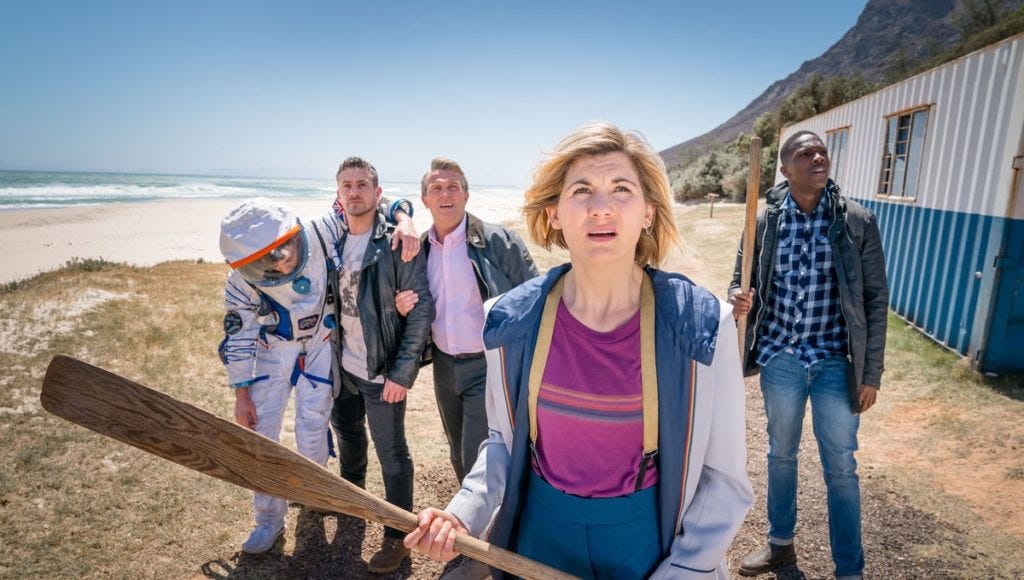
3. Greener Pastures
Even so, this episode includes nearly every element that we expect of a good New Who adventure, whether seemingly insoluble mysteries that don’t willingly yield clues, intriguing guest characters that accompany the Doctor and her friends along the way, or extraterrestrial threats that Team TARDIS must face down before the hour (or, in this case, 49-minute running time) ends.
By these measures, “Praxeus” doesn’t simply succeed, but follows a well-worn template that reassures us that “Fugitive of the Judoon’s” whiz-bang secrets haven’t so altered Doctor Who’s dramatic landscape that the program forgets its mission statement: Follow the Doctor as she travels through space and time, helping out where she can, and having fun in the process.
And, thanks to Jamie Magnus Stone’s crisp direction and some truly spectacular vistas shot on location in South Africa, “Praxeus” is loads of fun, hitting enough spooky notes to place it among the most entertaining one-off entries of Chibnall’s time as showrunner. Stone’s eye for poised compositions (that become jangled, hand-held shots necessitated by this installment’s action sequences) makes him, in only his second episode as director (he also helmed Series 12’s excellent premiere, “Spyfall: Part One”), among the best new crew members recruited by Chibnall and, in truth, one of New Who’s best overall directors, ranking up there with franchise stalwarts Joe Ahearne, Graeme Harper, Rachel Talalay, and, especially, Euros Lyn.
Stone and his production crew, in another victory, somehow make a Cape Town street so resemble one of Hong Kong’s back alleys that it fools even viewers (like myself) who’ve visited and enjoyed that city many times. The propulsive pace of McTighe’s and Chibnall’s script also helps explain why “Praxeus” is never less than fascinating to watch, having been edited and scored to near-perfection (by, respectively, Rebecca Trotman and Segun Akinola).
Yet this outing’s most important contribution is its resolute commitment to ecological justice, which arrives in the form of Team TARDIS discovering that the Praxeus bacterium is of extraterrestrial origin. This development becomes even more menacing when the Doctor determines that this alien pathogen neither unintentionally nor indiscriminately targeted Earth.
The keys to this breakthrough are Yaz’s smart and brave actions in teleporting herself and Gabriela to a disconcerting realm that Yaz initially mistakes for another planet, but whose real location and context unveil the covert reasons that Praxeus threatens to run rampant around the globe. When the Doctor arrives in this place with everyone else in tow (and in the TARDIS), she realizes that it is, in fact, located miles beneath the Indian Ocean, which explains why the missing American submarine’s conning tower is jammed next to piles of debris that are, in fact, the remnants of Suki Cheng’s actual laboratory.
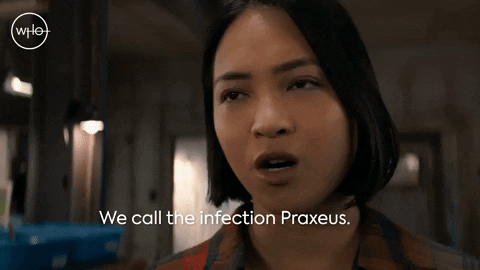
Suki, you see, is a member of an unnamed extraterrestrial species whose world was devastated by Praxeus, a bacterium that feeds on plastic as gleefully as I eat bacon. Or, as the Doctor summarizes when Graham protests that his body is not full of plastic, “It’s in the air, it’s in your food, it’s in your water. Humans have flooded this planet with plastics that can’t be fully broken down, so much so that you’re ingesting microparticles whether you know it or not. You’re poisoning yourselves, as well as your planet. An alien bacterium has come to this planet, and it found a feast.”
Does this dialogue punch us too directly on the nose? Might it sermonize too forthrightly? The fact that the Doctor’s diagnosis is spot-on means that I can’t reproach McTighe and Chibnall too harshly for telling the truth to audiences who need to hear such plain talk as frequently as possible. Jodie Whittaker delivers these lines matter-of-factly to avoid the hectoring tone that a lesser performer would allow to tip into unwelcome stridency.
The Doctor is aghast when she grasps that Suki and her hazmat-suited compatriots—beings who have attempted to kill Team TARDIS throughout “Praxeus”—were dispatched in lab ships to find a cure for the Praxeus plague before it exterminated every member of Suki’s species. Yes, in effect, Suki and her friends use Earth as a petri dish. Suki, however, soon falls victim to the bacterium, whose accidental release (caused by Suki’s shuttle crashing into the ocean weeks before this episode begins) constructs the toxic environment that now encases her spacecraft.
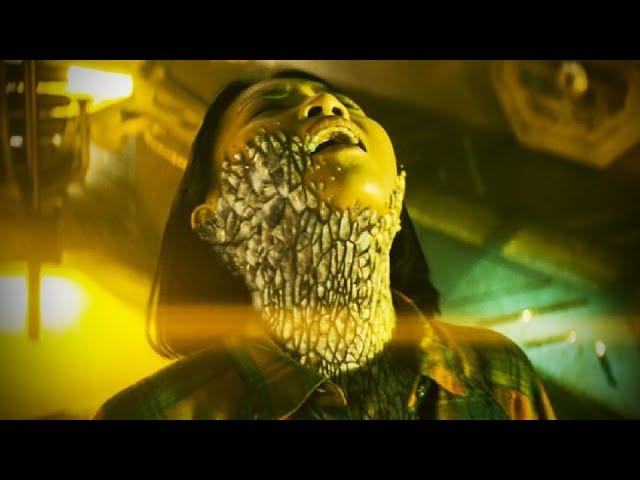
The bad news is that Praxeus infected birds in Peru and Madagascar, then jumped to human beings, and now threatens to spread around the world. Like the hopper-virus subplot featured in “Orphan 55,” this storyline’s parallels to the COVID-19 pandemic are, upon revisiting “Praxeus,” harrowing to contemplate even if McTighe and Chibnall had no idea what real life held in store for us all when they wrote this entry’s teleplay sometime in 2018 (probably in late summer or autumn, before revising their draft until filming began in February 2019).
These correspondences may also clarify why some audience members so dislike “Praxeus” (whose IMDb rating is a paltry 5.2 out of 10). It’s simply too true to life.
Or, more accurately, as true to life as an episode about extraterrestrial bacteria running wild on Earth can be. The dead birds also hold the crucial clue about curing Praxeus, having developed enough microbial resistance to the pathogen that the Doctor and Suki can extract and enhance an enzyme that nullifies and destroys the bacterium. They must use the ailing Adam—who was deliberately infected by Suki’s partners in Hong Kong—as both incubator and test subject, while the way they spread this medicine over Earth’s surface involves Jake piloting Suki’s shuttle into orbit (in a gripping sequence that doubles as a happy bit of Doctor Who flimflam).
What would any episode be, after all, if it neglected to pile absurdity atop eccentricity atop silliness that crosses into farce?
So, the good news, my friends, is that “Praxeus” nearly has it all, and, for viewers who enjoy a television series unashamed to wear its ecological conscience on its sleeve, nearly has it all ways. When Team TARDIS leaves Adam, Jake, and Gabriela on the Malagasy beach to travel the world together (and, especially, when Jake says, “We’ll take the planet from here”), the possibility of this trio forming a Torchwood-style unit that the Doctor can call upon for assistance in future escapades is tantalizing enough that, if Chibnall doesn’t bring these winning characters back to television, perhaps Big Finish Productions can enlist Warren Brown, Matthew McNulty, and Joana Borja to voice their roles in a few New Who audio dramas.
Ah, yes, we can hope.




